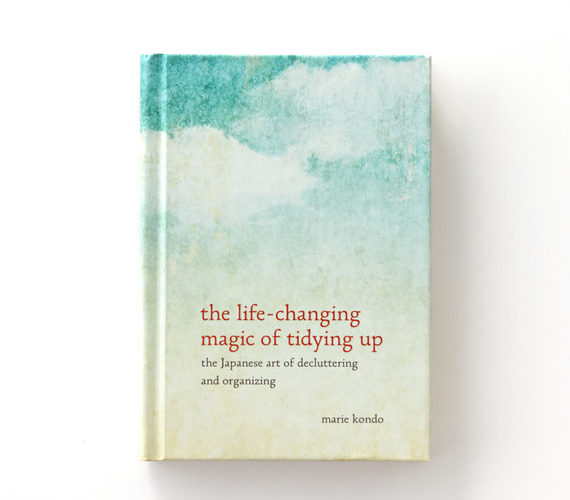“I’m not a book quitter!” Clutching The Life Changing Magic of Tidying Up, by Marie Kondo, I heard the words inadvertently escaping. “Why don’t you just stop reading it?” My girlfriend asked upon seeing me squirm under the covers, reading by nightstand light, brows furrowed, an occasional guffaw breaking the silence.
I really wanted to like Marie Kondo’s “The Life Changing Magic of Tidying Up: The Japanese Art of Decluttering and Organizing.” This was supposed to be right up my alley, a meshwork of interests: a practical guide towards self-improvement, simple living, minimalism, all from a Japanese Zen perspective. I guess I was expecting something a little headier, instead I got “The time they (socks) spend in your drawer is their only chance to rest. But if they are folded over, balled up, or tied they are always in a state of tension…” Oof.
The two main things that turned me off with Kondo’s tidying up book were tone and language. This critique probably needs a healthy caveat: the original text is Japanese so the vocabulary and translation may be limiting factors for both the author and translator. I wonder how differently I would react if I was Japanese? If I had a deep understanding of Japanese culture (that only a native Japanese person could have)? If I spoke, wrote and thought in Japanese?
I found the tone comfortably plopping itself into that cringeworthy groove of childish, yet authoritative — hey, no kettle calling black jokes here, OK?! You’ll hurt my feelings, hehe. From the perspective of an expert, she commands the reader (and her clients) to tidy, to adhere to a specific protocol and promises nothing less than eternal happiness if you’d just get your shit together.
Related: The Year of Less and Frugality
A few rather laughable testimonials are dropped. Here’s my (totally serious) rendition of one: “I took Ms. Kondo’s course on tidying. I was able to throw out or donate 1,000 bags of stuff. I’m so happy with my life. Because I can think more clearly now, I built a nuclear reactor in my basement. It has also changed my health and exercise regime immensely. Now, on the weekends, I spend most of my time flying above town, looking for people in distress who may need assistance.”
The language, or maybe more appropriately, the translation was at times tough to get past. I felt Kondo was trying to optimize her book like one would do for search engine optimization. She chills out a bit as you go along, but in the first few chapters she seemingly uses “tidy” and “tidying up” in every other sentence. Granted, it may be essential to the content, but I found myself fantasizing about getting one of those click counters that baseball pitching coaches use to count pitch amounts. Tidy… Click.
Kondo uses an additional word repeatedly throughout the book: “rebound.” She admonishes readers to avoid specific pitfalls that may make them “rebound” back into old habits. After the twentieth time, even David Robinson would say: “Hey, it’s freakin’ relapse!” So so silly, and this is probably more of a reflection on me than anything else, but this killed me.
Now that I’ve gotten that off my chest…Phew. Wow, I feel better now, don’t you?
There are admirable truisms undergirding Kondo’s message. “Spark Joy” will be her lasting contribution to readers, in fact, it’s the title of her companion follow-up book. A fundamental aspect of her eponymous KonMari Method is physically handling each item we get rid of and asking ourselves whether or not it sparks joy within us. If yes, keep it. If no, let it go. It forces us to be mindful about what we own. It challenges us to direct our attention to something and reassess it’s meaning. Is it truly valuable to us right now? Does it elicit a positive reaction within us? Has its meaning to us changed over time? I think these are good questions.
Related: You Can Achieve More with Less Using Pareto’s Law
She explains how the KonMari Method is “… not a mere set of rules on how to sort, organize, and put things away. It is a guide to acquiring the right mindset for creating order and becoming a tidy person.” But tidying is not the ultimate goal. “Tidying is just a tool, not the final destination. The true goal should be to establish the lifestyle you want most once your house has been put in order.” This was the meat I needed. It was a mental transition from the extreme make-over chat to the what-the-heck-are-we-doing-here conversation? You know, that one.
My knee-jerk (negative) reaction to consumerism provided a significant hurdle in reading the book. Each time she personified a sweater or glorified a thing, I kept thinking to myself: “It’s just stuff! I don’t like stuff!” For Kondo, however, tidying is a filtering process, a system to identify what is and isn’t important. Simple as it sounds, I think most of us (myself included…often, in fact) fall miserably short in this daily identification process . We think about things that are not important, we do things that are wasteful of our finite time. Perhaps the act of tidying and living in a tidy environment can better fine tune our ability to identify value.
Like a skipping stone, Marie Kondo only scratches the surface of depth, but delves down often enough to keep the reader engaged. In doing some recent basement clean-up, I found myself thinking about “spark joy.” Handling old pictures, artwork and camping supplies, I viewed items through a new lens…maybe, but I’m not about to start a dialogue with the residents of my underwear drawer anytime soon.


